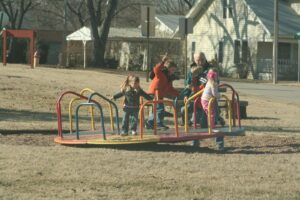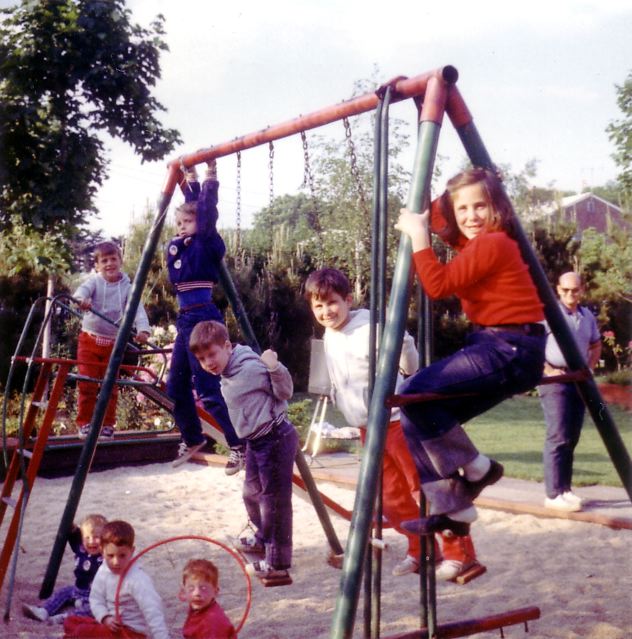In a post at Overlawyered, Walter Olson notes an article that says swings sets have been removed from a playground “in part because of lawsuits over injuries.” A West Virginia school district had just settled a suit over an injured child for $20,000. The key words from the short blog post? “In part.”
You see, an examination of the article reveals that the surface wasn’t safe. So let me summarize this post before you read the rest:
- Surface not safe
- Child injured
- Blame the laywers
Now let’s pick up where I left off, with the second link; an editorial to the business-minded Investors Business Daily. After relying on a few anecdotes to support its position that lawyers are clearly to blame for children being miserable, the paper starts quoting “authorities”:
“There is nothing left in playgrounds that would attract the interest of a child over the age of four,” Philip K. Howard, lawyer and author, wrote in the Wall Street Journal in 2008.
And then there is similar quote from Olga Jarrett, a Georgia State University professor, from remarks given to (surprise!) a tort “reform” group:
She blames “a fear of lawsuits that makes some school systems and cities design playgrounds that are completely uninteresting to kids.”
Oddly enough, my kids have no problem finding things that attract their interest on the playground, and they are clearly past the age of four. But then, my kids are looking to play, not looking to score political points in the debate over tort “reform.”
The editorial says that “America’s litigious society has changed the way kids play.” Well, yes and no. They still use the monkey bars the same way. But they aren’t doing so over a concrete surface, are they?
 In the parks we’ve gone to over the past years, we’ve seen an abundance of swings, slides and things to climb on and scamper over. I see happy faces running up, over and around equipment that was far safer than the public parks I went to as a kid. The only thing I see missing from my youth is the merry-go-round you stood on that others would spin ’round and ’round ’till you puked or were catapulted off onto the concrete. I know, some people liked to see their kids in danger.
In the parks we’ve gone to over the past years, we’ve seen an abundance of swings, slides and things to climb on and scamper over. I see happy faces running up, over and around equipment that was far safer than the public parks I went to as a kid. The only thing I see missing from my youth is the merry-go-round you stood on that others would spin ’round and ’round ’till you puked or were catapulted off onto the concrete. I know, some people liked to see their kids in danger.
Perhaps Investors Business Daily would like to return to the days of dangerous products, exploding Pintos, crippled children and Dalkon Shields. Perhaps. Unless, of course, the family member of one of the writers was hurt. Then, I’m sure, they would be singing a slightly different tune, like so many others.
Now about that photo of the kids on the swings you see up at the top right? That is a Turkewitz family photo shot by dad around 1967 in our backyard. I’m the kid in the red pants furthest from the camera, with my brothers and cousins scattered about. And note the soft surface my father installed. Even way back then we knew that you don’t want kids playing on equipment over dangerous surfaces.

Eric,
Generally, I agree that blaming lawyers for depriving kids of childhood fun makes for an attractive, albeit, deceptive argument for tort reformers.
I have both a comment and question. First, lawsuits are not the only reason for changes in playground equipment. There is also an increased focus on making playgrounds accessible to disabled children, which has also lead to the advent of equipment with ramps rather than steps, soft rubber and unconventional structures (for example, one park in my county features giant musical instruments and painted labyrinths). I think this is a positive development, and a blessing for families with disabled children because it enables siblings (who may already go to separate schools because of the disability) to play together.
My question, however is this. I assume that there are fewer playground accidents today, or at least, that they have been reduced in severity. But another change I’ve noticed that has coincided with changes in playground equipment is the increased presence of parents ALL THE TIME. When I was 5 or 6, my younger sister and I would bike to the local park together and to play. But when my daughters were growing up, if I even let them roam the park alone while I caught a nap on the bench (the joys of work life balance!), I’d get dirty looks. In any event, is it possible that increased parental oversight also accounts for reduction in accidents?
Carolyn:
You make a great point in there being more parental oversight today. Given the changes both in playground equipment, as well as social attitudes, an actual empirical study would be pretty tough to do.
And equipment is certainly different. My kids love the labyrinths and rock walls that they find. The stuff I see today is not only healthier from a physical standpoint, but more imaginative and stimulating. It’s also better constructed, partly as a result of newer materials they didn’t really have in the 50s and 60s.
Almost all of the old stuff is still there, except now it’s designed better. Remember the blistering hot metal slides? I’ll take the hard plastic, thank you very much, with zero downside to the kids.
I have read that children seem to have a “danger level” in play that they seek, and that if you provide them with too “safe” a playground, they will simply misuse it in order to get the dangerousness to the “right” level (e.g., climbing onto the roofs of those climbing structures, belly-flopping competitions on those “soft” surfaces). I certainly have observed more “misuse” of modern play equipment than I remember from when I was a child, but I may not be remembering everything. Still, it may be better to provide some play structures that are somewhat risky, but in a considered way, instead of trying to be totally safe and then waiting to find out what creative way the kids will think up to misuse it.
(There is one park in our town that still has one of those merry-go-round things. My company picnic has been there for the last couple of years, and each year, my daughter plays on it until she gets thrown off, comes to get the owie kissed, and then goes off to do something else.)
Those who are interested in these issues would probably be interested in the blog Free Range Kids (and also in the book of the same title).
Elizabeth, that doesn’t match my recollections at all from childhood – and even if it were so, falling off a climbing structure onto soft rubber is much safer than falling off onto concrete.
Tort ‘reformers’ here are tapping into the natural tendency of old fogies to rant about how coddled kids these days are, and to conveniently edit our memories so we don’t recall the very real dangers that led to these changes. Anyone who is nostalgic for children being rushed to the hospital for head injuries and broken bones is welcome to put up a rusty metal play structure over concrete in their own back yard.
Pingback: Swing sets removed from playgrounds
@Imaginary Lawyer: Agreed on the rubber part… I’m pretty sure few would argue for concrete to come back (well, except those whose kids have fallen on wood chips and gotten hundreds of splinters… but rubber doesn’t have splinters). The issue here though is the equipment itself. You mention “rusty metal play structure”… keep in mind that nowadays galvanized steel can prevent the rusting.
You may remember the swing sets and slides of your childhood being taller than those today. Many say that’s because you were smaller at the time. In most cases they would be right. However, this is one case where there is documented evidence (albeit very little of it) that the people with big memories are correct… the slides and swingsets actually WERE bigger back then. Now, here is a true story, originally posted by me on the controversial Post #980:
easily one of the best things I have ever read on the Internet. I am currently a 17-year-old boy in Tulsa, OK. Understandably, most of my playground experiences were with the new plastic stuff. Back when I was 4 years old I often went to Whiteside Park, which had a mix of plastic and painted wood. I remember a boy named Joe who used to be there many times… he could swing really high on the swings which were still the old chain kind (albeit with a plastic seat… I think it was a 8 or 10 foot swingset). AFAIK they still have the same equipment today, including the fiberglass 10-12′ straight and steep slide (not too many slides are straight anymore), though I haven’t been there in over 5 years. Another park, Darlington, had and still has all-metal equipment (though it’s a really small structure). However, LaFortune is the one I want to write about here. As late as 10 years ago they had old wooden equipment (with metal slides and bars). I remember some very high monkey bars (maybe 8 feet?), a swinging bridge (had to be pretty small… maybe 10′ long tops), and 3 straight metal slides, each bigger than the other (biggest one was maybe 10-12 feet). Back in 2000 or 2001 or so they changed to new plastic equipment. At the time I was very excited since they had changed from a relatively small structure to two large ones. In 2004 I had the opportunity to visit a playground untouched by litigation-fearful government. My great uncle was about to pass away, and the family took a 1-day trip to Aurora, MO, to see him one last time. Apparently not wanting me to see him in his poor condition, my mom found a playground and told my dad to play with me there (I was 10 at the time). That is an experience I will never forget… there were an old-style metal seesaw, a metal merry-go-round, and a very steep metal slide that had to be at least 15-20 feet tall. Being accustomed to plastic all my life, I was at first afraid of the big slide. From what I recall I eventually got on it and loved it… as well as the other stuff there. From what I see on Youtube some places still have this old-school equipment… but they are mostly in other countries (Germany pops up a lot). After reading this article and others like it I realize what has truly become of society today. This is not simply a problem with playgrounds, it extends to all aspects of daily life. The American legal system is becoming too constricting to organizations, often doling out six-figure amounts for accidents that deserve more reasonable payments in the range of zero to four figures (case in point: Liebeck v. McDonald’s Restaurants 1994, aka the Coffee Case). Though consumers may think they are getting a better product from the additional regulations, they are the ones who are really paying for them. Thus the governments force unintended mandatory “insurance policies” upon the people… businesses have to pay more and skimp on the product to meet regulations, and the consumer ends up paying for a few people’s troubles in the form of increased prices or inferior products. Change needs to occur in the law schools before it can occur on the playground.